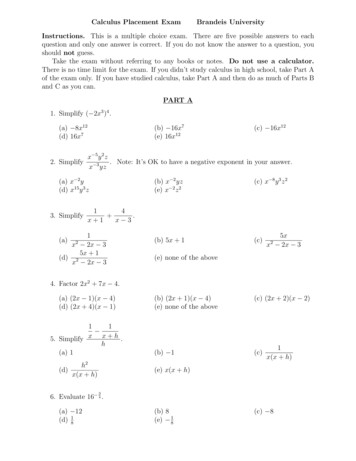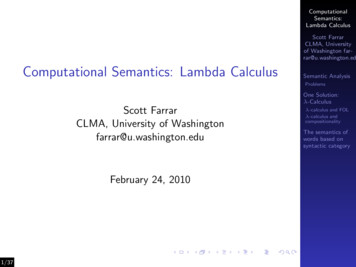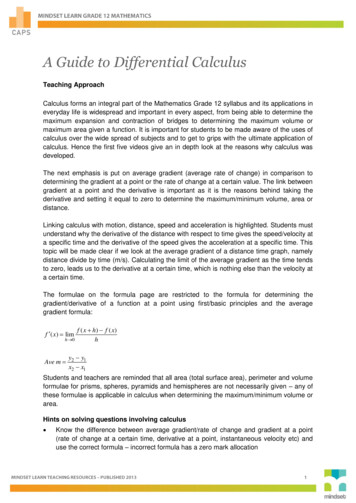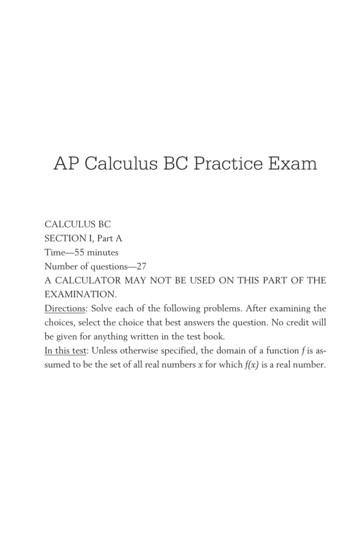
Transcription
Calculus Placement ExamBrandeis UniversityInstructions. This is a multiple choice exam. There are five possible answers to eachquestion and only one answer is correct. If you do not know the answer to a question, youshould not guess.Take the exam without referring to any books or notes. Do not use a calculator.There is no time limit for the exam. If you didn’t study calculus in high school, take Part Aof the exam only. If you have studied calculus, take Part A and then do as much of Parts Band C as you can.PART A1. Simplify ( 2x3 )4 .(a) 8x12(d) 16x72. Simplify(b) 16x7(e) 16x12x24. Factor 2x2 7x(a) (2x 1)(x(d) (2x 4)(x15. Simplify x1218(b) 5x 1(c)x2(b) (2x 1)(x 4)(e) none of the above(c) (2x 2)(x(b)(c)11x(x h)(e) x(x h)345x2x34.1x h .hh2x(x h)6. Evaluate 16(a)(d)(c) x 8 y 3 z 2(e) none of the above4)1)(a) 1(d)(b) x 2 yz(e) x 2 z 214 .x 1x 312x 35x 1(d) 2x2x 3(a)16x12x 5y2z. Note: It’s OK to have a negative exponent in your answer.x 3 yz(a) x 2 y(d) x15 y 3 z3. Simplify(c).(b) 8(e) 18(c)82)
7. Find the solution(s) of the equation x2 5x 1 0.(a)(d)2 and 8p215 2(b)1 and65 2(c)p21(e) no real solutionsx 3 0.x2 16(b) 4, 4(e) no real solutions8. Find the solution(s) of the equation(a)(d)3, 03(c)3, 4,49. Find the equation of the line through the points ( 4, 3) and (2, 0).(a) y (d) y 2x1x 22(b) y (e) y 2x 21x21x2(c) y 1y ! 3x 3y10. What is the slope of the line shown here?(a) 3(d)(b) 3(e) 113(c)13x22y ( x 1) 2y ( x ! 1) 2y 0y 011. Which of the graphs shown belowx 0 best represents the graphx 0 of y (x1)2 2?(a) Graph 1(b) Graph 2(c) Graph 3(d) Graph 4y ( ( x 1 ) 2 ! 2 if ! 3 xy 1 ) ( ( x ! 1 ) 2 ! 2 if ! 1 x 3 )(e) Graph 5y 0x 0Graph 1x 0Graph 382 x5, if x 112. Let f (x) x 4, if 1 x 2 . :3,if x 2(a) 3(d) 6 and 3y ( ! ( x ! 1 ) 2 2 if ! 1 x 3 )y 0y 0Graph 2x 0Graph 4Graph 5Find f (2).(b) 6(e) none of the above(c)1
13. Let f (x) (a)(d)371x31and g(x) 7x11. Find f (g(2)).1(b) 26(e) none of the above1014. Let f (x) 3x2(c)18x. Find f (x h) and simplify.(a) 3x2 3h2 x(d) 3x2 h2 xh(b) 3x2 6xh 3h2(e) 3x2 3h2 xxh(c) 3x2 3h2x h15. Suppose that the angle has measure 135 . What is the radian measure of ?(a) 3 radians4(d) radians(b) 4 radians(e) none of the above(c)16. Let be an angle. Which of the following statements are true?sin 11I. tan II. csc III. sec cos sin cos (a) only I is true(d) none of them is true(b) only I and IV are true(e) all four statements are true2 3radiansIV. cot 1tan (c) only II and III are true17. Which of the following statements are true?I. sin 4 12II. cos 2 3(a) only III is true(d) none of them is true12III. tan 0(b) only I and III are true(c) only II and III are true(e) all three statements are true1 have if 0 2 ?18. How many solutions does the equation 2 sin (a) two solutions(d) eight solutions(b) one solution(e) no solutions(c) four solutions19. Evaluate log2 18 .(a) 3(d) 2(b) 3(e) none of the above20. Write the expression 3 ln x (a) ln x3 (x 1)(d) ln x3 x 1(c)14ln(x 1) as a single logarithm. (b) ln 3x(x 1)(e) ln 3x x 1(c) lnh x 3 ix 1
21. Find the solution(s) to the equation log x 0.(a) 01(d) 10(b) 1(e) no real solutions(c) 10p22. Evaluate ln( 3 e).(a) can’t be evaluated(d) 3(b)(e)p3e(c) e1323. Find the solution(s) to the equation ln(x 2) 3.(a) 1(d) e32y (c) e3(b) 3 ln 2x22(e)ln 2y 2! xy 0y of0 y log x? 0 best represents the graph24. Which of the graphs shown xbelow2x 0(a) Graph 1(b) Graph 2(c) Graph 3(d) Graph 4y log 2x(e) Graph 5y 0x 0y ! log 2xGraph 1y 0y ! 2xGraph 2y 0x 0Graph 3x 0Graph 4Graph 5PART B1. Find limx!2xx22x2.(a) 0(d) 132. Find limx! 1(a) 34(d) 012(b) 3(e) doesn’t exist(c)(b) 14(e) 1(c) 1x3 5.4x3 x 1
!13. Find lim ex .2x! 1(a) 0(d) 1(b) e(e) 1(c) 1( x 1 ) 2 ( y ! 1 ) 2 0.0024. The graph of a function g(x) is shown below. Which of the following statements aretrue of g(x)?I. lim g(x) 2II. lim g(x) 1III. lim g(x) does not existIV. lim g(x) x! 1x! 1x! 1x!1V. lim g(x) does not exist(a) only I and IV are true(d) only II and V are true(b) only I and V are true(e) only III and V are truex)x!0xf (x x)(d) limx!0x(c) only II and IV are true65. f 0 (x) can be defined as:f (x 16 cos ( 1 0.12 )2x!1(a) lim1x) f (x)6 cos( 6 0.12)(c) limx(e) none of the above 7f (x)(b) limf (x x!0f (x)x! xf (x x)xf (x)6. Consider again the function g(x) whose graph is shown in problem 4. Which of thefollowing statements are true of g(x)?7I. g is continuous at x 1III. g is di erentiable at x 1V. g is di erentiable at x 1(a) only I and IV are true(d) only II and V are trueII. g is continuous at x 1IV. g is di erentiable at x 06 cos ( 7 0.12 )8 (c) only I and V are true(b) only II and IV are true(e) only III and V are true7. The graph of a function f (x) is shown below. At which of the following points is thevalue of the derivative f 0 (x) biggest?(a) at x 1(b) at x 2(c) at x 3.5(d) at x 6(e) at x 78. Consider again the function f (x) whose graph is shown in problem 7. At which pointsis the second derivative f 00 (x) negative?(a) at x 2 and x 3.5(d) at x 7 only(b) at x 1, x 2 and x 3.5(e) at x 6 and x 7(c) at x 6 only
9. Let f (x) ln x · cos x. Find f 0 (x).1· ( sin x)cos x1(d)( cos x x sin x)x cos x(a)10. Let y 4etan x . Find(b)1· ( sin x)xln x sin xdy.dx(b) 4etan x ·(d) 4etan x · cot x(e) 4 sec2 x11cos xx(e) none of the above(a) 4etan x · sec2 x11. Let f (x) sin(c)11 x2(c) 4etan xx. Find f 0 (0).(a) (d) 0(b) 1(e) none of the above(c)1212. The equation of the line tangent to the graph of f (x) x2 5x at the point withx-coordinate x 2 is:(a) y 9x 14(d) y 19 x 2913. Let f (x) x3(b) y 9x(e) none of the above(c) y 9x43x. Which of the following statements are true?I. f (x) has local maxima at both x 1 and x 1.II. f (x) has a local minimum at x 1 and an inflection point at x 0.III. f (x) has both a local minimum and an inflection point at x 0.(a) only I is true(d) only I and III are true(b) only II is true(c) only III is true(e) none of the statements is true14. A commercial nursery has 1000 yards of fencing which the owners plan to use to encloseas large a rectangular garden as possible. The garden will be bounded on one side bya barn, so no fencing is needed on that side. How large will the garden be (in squareyards)?(a) 125,000 sq yds(d) 62,500 sq yds(b) 250,000 sq yds(e) none of the above(c) 111,088.89 sq yds15. The width of a rectangle is increasing at a rate of 2 cm/sec, and its length is increasingat a rate of 3 cm/sec. At what rate is the area of the rectangle increasing when itswidth is 4 cm and its length is 5 cm?(a) 31 cm2 /sec(d) 22 cm2 /sec(b) 23 cm2 /sec(e) none of the above(c) 5 cm2 /sec
16. A rock is dropped from a height of 400 feet and falls toward the earth in a straightline; t seconds after it is dropped, it has fallen a distance of s(t) 16t2 feet. At whatspeed is the rock traveling when it hits the ground?(a) 20 ft/sec(d) 320 ft/sec(b) 32 ft/sec(e) 160 ft/sec(c) 640 ft/secPART C1. Which of the following gives the area between the curves y x2 and y 2x over theinterval [ 2, 2]?(a)(d)Z 2(xZ 2222(x22x) dx(b)2x) dxZ 22(2x2x ) dx(c)Z 02(x22x) dx Z 20(2xx2 ) dx(e) none of the above2. Suppose that f (x) is a continuous function with the following properties: f 00 (x) cos x,f 0 ( ) 2 and f (0) 4. What is f ( )?(a) 2(d) 6 2 (b) 2 (e) 0(c) 23. Suppose that the function f (x) is defined by f (x) (a) ex ln x(d)exx(b) ex ln xeexxZ x(c)1etdt. Find f 0 (x).texx(e) the integral can’t be computed, so it’s impossible to give the answerZ x4. Let F (x) f (t) dt, where f (t) is the function shown below. Which of the following0statements are true?I. F ( 2) F ( 4)III. F (0) 0(a) only I is true(d) only I and II are trueII. F (2) F (1)IV. F ( 1) 0(b) only II is true(e) only II and IV are truet(c) only III is true
Z 2x5. Suppose that f (x) 2. Findf 0 (x) dx.x 10(a) 25(d) 0(b) 2825(e) none of the above2825(c)6. Which of the following statements about indefinite integrals are true?I.ZIII.f (x) g(x) dx ZZf (x) dx Zg(x) dxf 0 (g(x))g 0 (x) dx f (g(x)) C(a) only I and II are true(d) only I, II and IV are trueII.ZIV.Zf (x)g(x) dx [f (x)]n dx Zf (x) dx ·n 1[f (x)]n 1Zg(x) dx C(b) only I and III are true(c) only I and IV are true(e) only I, III and IV are true7. Find the volume of the solid obtained by rotating the region bounded by y x2 andy x over the interval [0, 1] around the x-axis.(a)(d)Z 10 (xZ 1024x ) dxp ( y8. The integral(b)y) dyZ(e)Z 10Z 102 2 (xx ) dx (yy 2 ) dy(c)Z 1(c) 1201dx can be found byx ln x(a) making the substitution u ln x(b) making the substitution u 1x(c) using integration by parts, with u ln x and dv x(d) taking the reciprocal of(e) none of the above9. The integralZZx ln x dxx sin x dx can be found by(a) making the substitution u x(b) making the substitution u sin x(c) using integration by parts, with u sin x and dv x dx(d) using integration by parts, with u x and dv sin x dx(e) none of the above10. FindZ ln p30(a) ln 2(d) 4exdx1 e2x(b) 1(e) 0 (x2x4 )2 dx
11. Find limxx!0sin x.x3(a) 0(d) 1312. FindZ 1116(b) 1(e) does not exist(c)(b) 2(e) the integral diverges(c) 101dx.x2(a) 1(d) 2013. Which of the following improper integrals converge to a finite value?(I)Z 11exdx(II)(a) I only(d) I and III onlyZ 113x dx(III)Z 11(b) III only(e) all of them(c) I and II only14. The second order Taylor polynomial at x 0 for f (x) e(a) 1(d) 1x22x x1dx1 x2(e) 1isx22(b) 1 2x(c) 1 x x22x2x 215. Which of the following series converge?(I)1Xn 1(a) (I) only(d) (I) and (III) only1n2(II)1Xn 11n(III)n 1(b) (III) only(e) all of them16. The radius of convergence of the power series1X1Xn2n(c) (I) and (II) onlyxn isn 0(a) 0(d) 3(b) 1(e) 1(c) 2
Math 20a Placement Exam (Part D)1: Consider the linear system3x y2y2x 6z 2z 182The solution set to this system in vector form is given by:80 1 0 1 0 1 980 1 0 1 0 1 91111 x x @A@A@A@A@A@y 4 3 zy 3 4 Az(a)(b):;:;z01z1080 1 0 1 91 x @A@y 3A z(c):;z12: Compute the following determinants. 6 1(a)2 3i.03(b) @302011 21 0A1 4i. 3ii. 18iii. 16iv. 12ii. -6iii. 0iv. 63: Let S be the plane given in parametric form by80 1 0 10 114 1@1 A @1 A y @ 0 A z:3010 14@1 A lie on the plane S?Does the vector4(a) Yesy, z 2 R9 ;.(b) NoOver
4: Find the dot product and cross product of the vectors a i 2jb 4i 3k.2k and(a) a · b i. 10ii. 4i2j 1kiii. -2iv. (6, 5, 8)iii. 10iv. -2(b) a b i.6i 5j 8k ii. (6, 5, 8)pp5: Let v h1, 3i and w h3, 3i.(a) The length of v, kvk i. 4ii.p4(b) Compute the dot product v · w.i. 10ii. 6(c) Compute the interior angle between v and w.i. /6ii. /4iii. /3iv. /26: Write the parametric equation of the line passing through P (5, 0, 2) andQ (1, 1, 7).88 x 1 4t x 5 2t(a) y 1 t(b) y 2t ::z 7 9tz 2 92 t(c) Both of the above(d) None of the above7: Find the equation of the plane containing the three points P ( 1, 2, 3), Q (0, 4, 1), and R ( 1, 3, 2).(a)x yz 0(b) y z 50 1 0 1318: For which value(s) of k are the vectors @ 1A, @k A perpendicular?22(a) 7(b) 0(c) 7 & 0(d) -29: (a) Find the orthogonal projection of h4, 1, 0i onto the plane 2xi. h2, 2, 0iii. h1, 1, 1i(b) Find the point on the plane xP (4, 1, 0).2y 2z 0.iii. h3, 2, 1iy z 0 which is closest to the point
i. (2, 2, 0)ii. (1, 1, 1)iii. (3, 2, 1)(c) Compute the distance between P (4, 1, 0) and the plane xppi. 1ii. 17iii. 3y z 0.
Calculus Placement Exam Brandeis University Instructions. This is a multiple choice exam. There are five possible answers to each question and only one answer is correct. If you do not know the answer to a question, you should not guess. Take the exam without referring to any books or notes. Do not use a calculator. There is no time limit for .










